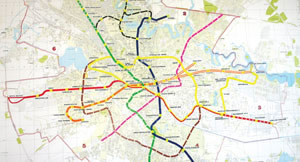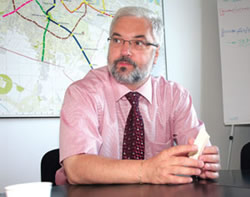Going underground
Linking up the south and the centre to the airport are among the plans for the Bucharest underground, finds Corina Mica
 As Bucharest’s rush hour streets choke with traffic and the buses and taxis come to a standstill due to mass building work and a record number of car owners, the capital’s commuters will begin to head underground to get to work on time.
As Bucharest’s rush hour streets choke with traffic and the buses and taxis come to a standstill due to mass building work and a record number of car owners, the capital’s commuters will begin to head underground to get to work on time.
However, Bucharest’s Metro, though not overcrowded, is sparse, offering only four short lines - a fraction of the size of its Paris counterpart.
But slowly the city’s underground train company Metrorex is proposing new extensions, from up to Henri Coanda airport to a new line linking the south, using finance (hopefully) from Japan and Europe.
Eastern promise
The company is now focusing on is the completion of the south-eastern extension of the M1 line – an initiative started under Nicolae Ceausescu.
The extension is 4.8 km long and has four metro stops - Nicolae Grigorescu 2, 1 Decembrie 1918, Policolor and Linia de Centura - the last coinciding with the exit to the Bucharest-Constanta highway. So far the cost is 200 to 230 million Euro.
The money to fund this came from the local administration, loans from the European Investment Bank (EIB) and the state. This extension was part of Ceausescu’s plan to establish an industrial platform at the eastern end of Bucharest, with paint firm Policolor, the Drugs Factory (now Zentiva) and the Glass Plant (now Stirom) as a springboard for a future industrial platform.
It didn’t quite work out.
 “When the 1989 Revolution came, almost all companies collapsed and the plans to establish an industrial platform were dropped,” says Metrorex general manager Liviu Soava. “This also happened to the proposed metro line extension, where work started in 1989.”
“When the 1989 Revolution came, almost all companies collapsed and the plans to establish an industrial platform were dropped,” says Metrorex general manager Liviu Soava. “This also happened to the proposed metro line extension, where work started in 1989.”
Soava says the underground structure is complete, ventilation, lighting and electrical equipment are being installed and the line should be operational by the end of 2007 or beginning of 2008.
This can happen once the Parliament passes one more 35 million Euro loan agreement with the EIB at the end of this month.
Northern exposure
Another project in the works is the M4 line, from Basarab towards Laromet, in north-west Bucharest. There are two metro stops operating on this line – Grivita and 1 Mai, with two further stations in the works - Pajura and Parcul Bazilescu.
“This project is suffering some delays, and we hope to have it operational by 2010,” says Soava.
Above the tunnel are 19th century viaducts that supply drinking water from Rosu and Arcuda.
“Just try to imagine the magnitude of the damage if, by mistake, we disrupt the water supply of Bucharest,” says Soava.
Southern comfort
Metrorex’s next bet is the proposed M5 line, linking the southwest neighbourhood of Drumul Taberei to Cora Pantelimon in the east. This massive project’s first section, from Ghencea football stadium to Universitate, will have 13 stations, 9.8 km and cost about 500 million Euro. Soava says that talks with EIB started in 2003.
“EIB will do its own analysis by Autumn this year and in early 2007 we hope to sign the loan agreement,” he adds.
Building this new metro line could take between six and eight years.
Soava foresees problems could be encountered in the Hasdeu Bridge (near the existing Izvor metro station) and Iancului in the east. “This area is marked by narrow streets, old buildings and a high density of people living or working in the area,” he says. “Launching such a huge building project could harm all parties.”
The M5 line will have the novelty of a shorter distance between stations. The difference in length between Metro stops in Bucharest is on average 1.25 km – twice the worldwide average (of about 600 metres). “If the financing arrives in time and we do not encounter huge problems when building the line, I hope the first section of this new line [Ghencea – Universitate] will be ready by 2014,” says Soava.
Meanwhile, Mayor Vi-deanu is also conscious of the long spaces between lines in relation to other European cities and aims to increase the density of stations on the existing lines with 22 or 23 further stops.
Flight connection
The proposed project to build a metro line to connect central Bucharest to the Henri Coanda international airport in Otopeni is coordinated by the Bucharest City Hall, not Metrorex.
“A lot of people called it ‘megalomaniac’ but I see it as normal because in every single European capital there is an underground connection between the main airport and the city,” says Mayor Videanu.
Stations which could link up to the airport are Aurel Vlaicu, Aviatorilor or 1 Mai. This line will be almost 14 km long with 14 stations. Financing should be assured by the Japan Bank for International Cooperation (JBIC). But the agreements must be signed before Romania joins the European Union, because the Japanese Bank only funds developing countries.
There are two stages to the project. The first is underground to the north, the second, beyond the city limits, is overground.
City Hall reckons the project will cost in the region of one billion Euro.
“The feasibility study states this will have a very good profitability,” says Gheorghe Udriste, executive manager of urban transport, roads and traffic safety in the Bucharest City Hall.
But Soava says the overground section is no longer a valid proposal.
“Huge residential projects have started past the city limits, in Baneasa, hence huge increases in land prices, which would have to be expropriated for such a line to be built,” says Soava. “Moreover, when you build a line overground you have to consider the terrible winter blizzards as well as extreme heat in the summer, which will impede its normal functioning.”
Staying underground is thus the only option, argues Soava.
By the end by his mandate in 2009, Videanu hopes the works to this southern line will start. “Together with the Ministry of Transport and Metrorex, if we will find a financial support, we will start this project next year,” he says.
With financing and the right conditions in place, this line could be running by 2014.
METRO FACTS
Bucharest’s first metro line went into operation on 19 November 1979.
At that point it had 8.1 km in length, between Semanatoarea and Timpuri Noi and six stations.
Now it has 45 stations and 62.4 km, operating 5 am to around 11:30 pm at every eight to 16 minutes off peak and four to five minutes at rush hours.
It carries around 250 million passenger journeys a year.
